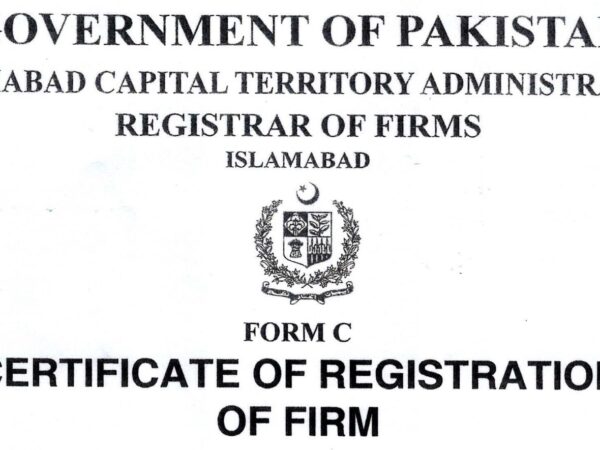
Registration Process for Approval as Non-Profit Organizations under of Section 2(36)(C) of the Income Tax Ordinance, 2001
In Pakistan, non-profit organizations (NPOs) play a crucial role in addressing various social, educational, and healthcare needs. These organizations, driven by a sense of social responsibility and humanitarianism, strive to make a positive impact on the lives of others. However, to operate legally and avail of tax exemptions, NPOs must undergo a registration process under Clause (36) of Section 2 of the Income Tax Ordinance, 2001. This blog aims to provide a comprehensive guide for NPOs seeking registration under this provision.
Eligibility Criteria for Registration
To be eligible for registration under Clause (36), an NPO must meet the following criteria:
Non-Profit Motive: The organization must be established for charitable, religious, educational, or other public purposes without any intention of making a profit.
Non-Political Affiliation: The organization must not be affiliated with any political party or engage in political activities.
Public Benefit: The organization’s activities must be directed towards the public benefit and not for the benefit of a particular group or individual.
Legal Existence: The organization must have a legal existence, either as a trust, society, or an association registered under the relevant laws.
Required Documents for Registration
The application for registration under Clause (36) must be accompanied by the following documents:
Application Form: The organization must fill out the prescribed application form, providing details such as the organization’s name, objectives, activities, and financial information.
Memorandum of Association or Trust Deed: Copies of the organization’s memorandum of association or trust deed should be attached.
Certificate of Incorporation or Registration: The organization must provide a copy of its certificate of incorporation or registration from the relevant authority.
Financial Statements: Audited financial statements for the preceding three years, if available, should be submitted.
List of Governing Body Members: A list of the organization’s governing body members, including their names, addresses, and designations, must be provided.
Detailed Activity Plan: A detailed plan of the organization’s activities for the upcoming year should be submitted.
Registration Procedure
Submission of Application: The completed application form along with the required documents must be submitted to the Commissioner of Income Tax (CIT) in the relevant jurisdiction.
Scrutiny and Verification: The CIT will scrutinize the application and supporting documents to ensure compliance with the eligibility criteria and completeness of information.
Approval or Rejection: If the application is found to be in order, the CIT will grant approval, and the organization will be registered under Clause (36). In case of any discrepancies or non-compliance, the CIT may request further information or reject the application.
Validity of Registration
Once granted, registration under Clause (36) is valid for the tax year in which it is granted and the following tax year. To remain registered, the organization must submit an annual statement to the CIT detailing its activities and financial situation.
Benefits of Registration
Registration under Article (36) provides many benefits to Non-Profit Organizations, including:
Exemption from Income: Non-profit organizations receive income from philanthropic, charitable, Religious, educational or other public purposes are exempt from revenue.
Tax Deductible Donations: Donations to non-profit organizations are tax deductible for the donor.
Building trust: Registration provides legitimacy and increases the organization’s trust with donors, partners and the public.
Access to Government Grants: Registered nonprofit organizations may be eligible for government grants and funding.
Consequently, registration under Section 2(36) of the Income Tax Act 2001 is essential for the functioning of a non-profit organisation. Gain tax benefits and increase legal credibility. By following the prescribed registration process and adhering to appropriate standards, nonprofit organizations can effectively meet the social, educational, and nutritional needs of their communities.

Register Company in Chamber of Commerce
Registering your company with the Chamber of Commerce in Pakistan is an important step towards establishing a legitimate business. The Chamber of Commerce is an organization that facilitates business development and growth by providing various services and resources. In this blog, we will discuss the process of registering your company with the Chamber of Commerce in Pakistan.
Step 1: Determine the Type of Chamber of Commerce
Pakistan has several chambers of commerce at the federal, provincial, and district levels. The first step in registering your company with the Chamber of Commerce is to determine which chamber is appropriate for your business. This decision will depend on the location of your business and the scope of your operations.
Step 2: Gather the Required Documents
Once you have determined which Chamber of Commerce to register with, the next step is to gather the required documents. The documents required for registration may vary depending on the Chamber of Commerce, but generally include:
- A copy of the company’s registration certificate
- A copy of the National Tax Number (NTN) certificate
- A copy of the National Identity Card (NIC) of the company’s directors
- A copy of the Memorandum and Articles of Association (MAA)
- A copy of the company’s bank statement
Step 3: Submit the Application Form
After gathering the required documents, the next step is to submit the application form. The application form can be obtained from the Chamber of Commerce’s website or in-person at their office. The application form will ask for basic information about the company, including its name, address, and contact details.
Step 4: Pay the Registration Fee
Once the application form has been submitted, the next step is to pay the registration fee. The registration fee may vary depending on the Chamber of Commerce and the type of business being registered. Payment can be made either online or in-person at the Chamber of Commerce’s office.
Step 5: Receive the Chamber of Commerce Membership Certificate
After the application form and registration fee have been submitted, the Chamber of Commerce will review the application and verify the documents submitted. If everything is in order, the Chamber of Commerce will issue a membership certificate. The membership certificate is a legal document that confirms the company’s registration with the Chamber of Commerce.
In conclusion, registering your company with the Chamber of Commerce in Pakistan is a straightforward process that involves determining the appropriate Chamber of Commerce, gathering the required documents, submitting the application form, paying the registration fee, and receiving the membership certificate. By registering your company with the Chamber of Commerce, you can gain access to various resources and services that can help you grow and develop your business.

Import Export License in Pakistan
If you’re planning to import or export goods in Pakistan, you’ll need a Web-Based One Customs (Weboc) license. The license is mandatory for traders who want to clear their goods through the customs department. In this article, we’ll guide you on how to obtain a Weboc license in Pakistan.
Step 1: Get Registered with Federal Board of Revenue (FBR)
To apply for a Weboc license, the first step is to register with the Federal Board of Revenue (FBR). You can either register online on the FBR website or visit the nearest FBR office to complete the registration process. You’ll need to provide your National Tax Number (NTN) and your Sales Tax Registration Number (STRN) during the registration process.
Step 2: Apply for a Weboc Account
Once you have registered with the FBR, you can apply for a Weboc account by visiting the Pakistan Customs Computerized System (PACCS) website. Click on the ‘Weboc Online Application’ link and fill out the application form. You’ll need to provide your personal and business details, including your NTN, STRN, and bank details. You’ll also need to upload a scanned copy of your national identity card (NIC) and other required documents, such as your import/export license.
Step 3: Wait for Approval
After you’ve submitted your application, it will be reviewed by the Weboc team. If they need any further information or documentation, they’ll contact you through the email address or phone number provided in your application. Once your application is approved, you’ll receive a username and password for your Weboc account. You can log in to your account and start using Weboc to process your import/export shipments.
Step 4: Payment of Fees
After your application is approved, you’ll need to pay the license fee to the State Bank of Pakistan. You can either pay the fee online or visit the nearest State Bank branch to make the payment. Once the payment is confirmed, your license will be activated, and you can start using it to clear your shipments through the customs department.
In conclusion, obtaining a Weboc license in Pakistan is a straightforward process. You’ll need to register with the FBR, apply for a Weboc account, wait for approval, and pay the license fee. With your Weboc license, you’ll be able to clear your import/export shipments through the customs department easily.

Company Registration in SECP.
In Pakistan, the Securities and Exchange Commission (SECP) is the governing body responsible for regulating and supervising the capital market, securities, and other related activities. If you’re looking to start a company, you’ll need to register it with the SECP. In this blog, we’ll take a look at the process of company registration in Pakistan.
Step 1: Choosing the Company Name
The first step in the company registration process is to choose a unique name for your company. The SECP has strict guidelines when it comes to company names. The name you choose must not be similar to any other company already registered with the SECP. It must not be offensive or violate any copyright laws.
Step 2: Obtaining Digital Signature and National Tax Number (NTN)
To start the company registration process, you’ll need to obtain a digital signature and National Tax Number (NTN). You can apply for both of these online through the Federal Board of Revenue (FBR) website. The digital signature is necessary for online company registration, and the NTN is required for tax purposes.
Step 3: Drafting the Memorandum and Articles of Association (MOA/AOA)
The Memorandum and Articles of Association (MOA/AOA) outline the company’s purpose and how it will operate. You’ll need to draft these documents and get them attested by a notary public. You can also get these documents drafted by a lawyer.
Step 4: Filing Online Application with SECP
After you’ve completed the previous steps, you can file an online application with the SECP. You’ll need to create an account on the SECP eServices portal and fill out the registration form. The form will ask for details such as the company name, type of company, the share capital, directors’ details, and address.
Step 5: Payment of Fees
Once you’ve submitted the online application, you’ll need to pay the registration fee. The fee will depend on the type of company you’re registering and the amount of authorized share capital. You can pay the fee online through the SECP eServices portal.
Step 6: Certificate of Incorporation
After the SECP has reviewed your application and approved it, they’ll issue a Certificate of Incorporation. This certificate is proof that your company has been registered with the SECP.
Step 7: Registering for Other Required Registrations
After you’ve obtained your Certificate of Incorporation, there are a few other registrations you’ll need to complete, such as registration with the Federal Board of Revenue (FBR), the Employees’ Old Age Benefits Institution (EOBI), and the Provincial Employees’ Social Security Institution (PESSI).
In conclusion, the company registration process in Pakistan involves several steps, including choosing a unique name, obtaining a digital signature and National Tax Number, drafting the MOA/AOA, filing an online application with the SECP, paying the registration fee, obtaining the Certificate of Incorporation, and registering for other required registrations. It’s essential to follow all the guidelines and regulations set by the SECP to avoid any issues in the future.

Trademark Registration with the Intellectual Property Organization (IPO) of Pakistan
If you own a business, it’s important to protect your brand and intellectual property. One way to do this is by registering a trademark with the Intellectual Property Organization (IPO) of Pakistan. In this blog, we’ll take a look at the process of trademark registration in Pakistan.
Step 1: Trademark Search
The first step in the trademark registration process is to conduct a search to make sure that your desired trademark is not already registered or similar to existing trademarks. This search can be done on the IPO website or in person at the Trademarks Registry Office in Islamabad.
Step 2: Filing of Trademark Application
Once you’ve conducted a search and confirmed that your trademark is available, the next step is to file a trademark application with the IPO. You can file this application online through the IPO e-services portal or in person at the Trademarks Registry Office.
The application must include the following information:
The name and address of the trademark owner
The trademark itself
The goods or services that the trademark will be used for
The class of goods or services (the IPO follows the Nice Classification system)
Step 3: Examination of Trademark Application
After filing the trademark application, the IPO will examine it to ensure that it meets all the requirements. The examination will verify that the trademark is distinctive, not offensive, and not similar to any existing trademarks.
Step 4: Publication in Trademarks Journal
If the IPO is satisfied that your trademark meets all the requirements, it will publish your trademark in the Trademarks Journal. This publication serves as a public notice to give other people the opportunity to oppose your trademark registration.
Step 5: Opposition Period
After your trademark is published in the Trademarks Journal, there is a two-month opposition period. During this time, anyone can oppose your trademark registration by filing an opposition with the IPO.
Step 6: Registration and Payment of Fees
If no opposition is filed during the opposition period, the IPO will issue a Certificate of Registration, and you’ll need to pay the registration fee. The Certificate of Registration serves as proof of ownership and protection of your trademark.
Step 7: Renewal of Trademark Registration
Trademark registrations are valid for ten years, and you’ll need to renew your trademark registration after every ten years. The renewal process is similar to the initial registration process, and you’ll need to pay the renewal fee.
In conclusion, trademark registration in Pakistan involves conducting a trademark search, filing a trademark application, examination of the application, publication in the Trademarks Journal, opposition period, registration and payment of fees, and renewal of trademark registration. It’s important to follow all the guidelines and regulations set by the IPO to ensure that your trademark is adequately protected. Registering your trademark is an essential step in safeguarding your brand and intellectual property.

Pakistan Engineering Council (PEC) Registration for Construction Firm
In Pakistan, the Pakistan Engineering Council (PEC) is responsible for the registration and accreditation of engineering professionals and firms. If you own a construction firm in Pakistan, getting PEC registration can provide you with several benefits, including greater credibility, access to government projects, and recognition in the engineering community. In this blog, we’ll take a look at the process of getting PEC registration for your construction firm.
Step 1: Meeting the Eligibility Criteria
Before applying for PEC registration, it’s essential to ensure that your construction firm meets the eligibility criteria. To be eligible for PEC registration, your firm must have at least one professional engineer as a partner or employee, and must have completed at least one project of a specified size and scope.
Step 2: Preparing the Application
Once you’ve established your firm’s eligibility, you can begin preparing your PEC registration application. The application requires several documents, including:
A copy of your firm’s registration certificate from the relevant government authority
A copy of your firm’s tax registration certificate
A copy of your firm’s professional indemnity insurance policy
A list of your firm’s partners and employees, including their qualifications and experience
A list of your firm’s completed projects, including project details and client references
A statement of your firm’s quality assurance and control procedures
Step 3: Submitting the Application
After preparing your application, you can submit it to the PEC along with the required fee. The PEC will review your application and verify the information provided. The verification process may include site visits to your firm’s office and completed projects.
Step 4: Approval and Registration
If your application meets the PEC’s requirements, the PEC will approve your registration and issue a registration certificate. The certificate will include your firm’s registration number, category, and validity period.
Step 5: Renewal and Compliance
Once registered with the PEC, your construction firm will need to renew its registration annually and comply with the PEC’s code of conduct and regulations. The PEC may conduct periodic audits and inspections to ensure compliance with its requirements.
In conclusion, getting PEC registration for your construction firm in Pakistan involves meeting the eligibility criteria, preparing and submitting the application, and obtaining approval and registration from the PEC. It’s important to follow the PEC’s requirements and regulations to ensure compliance and maintain your registration status. PEC registration can provide your construction firm with greater credibility and recognition in the engineering community, as well as access to government projects and opportunities.

Partnership Firm Registration
In Pakistan, a partnership firm is a type of business structure in which two or more individuals carry on business together with a view to making a profit. If you’re starting a partnership firm in Pakistan, one of the first steps you’ll need to take is to register your firm with the Firm Registrar. In this blog, we’ll take a look at the process of registering a partnership firm before the Firm Registrar in Pakistan.
Step 1: Choosing a Name for Your Partnership Firm
The first step in registering a partnership firm is to choose a name for your firm. The name must be unique and should not already be in use by another partnership firm or business entity. You can check the availability of a name by conducting a name search on the Firm Registrar’s website.
Step 2: Preparing the Partnership Deed
The next step is to prepare a partnership deed, which is a written agreement between the partners that outlines the terms and conditions of the partnership. The partnership deed should include details such as the name of the firm, the names and addresses of the partners, the nature of the business, the capital contributions of each partner, and the profit-sharing ratio.
Step 3: Stamp Duty and Notarization of the Partnership Deed
Once the partnership deed is prepared, it must be stamped with the appropriate stamp duty and notarized by a notary public. The stamp duty is calculated based on the value of the capital contribution of the partners.
Step 4: Submission of Documents to the Firm Registrar
After the partnership deed has been stamped and notarized, it must be submitted to the Firm Registrar along with the following documents:
A copy of the partnership deed
A copy of the national identity cards of the partners
A copy of the utility bill of the place of business
Step 5: Payment of Registration Fee and Receipt of Certificate
Once the documents have been submitted, the partnership firm will need to pay the registration fee to the Firm Registrar. After payment of the fee, the Firm Registrar will issue a certificate of registration for the partnership firm.
In conclusion, registering a partnership firm before the Firm Registrar in Pakistan involves choosing a name for your firm, preparing a partnership deed, stamping and notarizing the partnership deed, submitting the documents to the Firm Registrar, and paying the registration fee. It’s important to ensure that you follow the necessary steps and comply with the requirements to obtain the certificate of registration for your partnership firm. Once registered, your partnership firm will be legally recognized and can conduct business in Pakistan.

Company’s Annual Filing in SECP
In Pakistan, companies registered under the Companies Act 2017 are required to file annual returns and financial statements with the Securities and Exchange Commission of Pakistan (SECP) on a regular basis. These annual filings are important for maintaining the company’s legal status and compliance with regulatory requirements. In this blog, we’ll take a look at the annual filings that companies are required to make before the SECP.
Annual Returns
The annual return is a document that provides an overview of the company’s current status and activities over the past year. It includes details such as the company’s registered office, the names and addresses of its directors and shareholders, and the details of any changes to the company’s share capital during the year.
The annual return must be filed within 42 days after the end of the company’s financial year. If the company fails to file the annual return within the specified time, it may be subject to penalties and fines.
Financial Statements
The financial statements are a detailed report of the company’s financial performance over the past year. The report includes the company’s income statement, balance sheet, and cash flow statement. It also includes the auditor’s report, which provides an independent assessment of the company’s financial performance.
The financial statements must be prepared in accordance with the International Financial Reporting Standards (IFRS) and must be audited by a registered auditor. The financial statements must be filed with the SECP within 30 days of their approval by the company’s board of directors.
Annual General Meeting
In addition to filing the annual return and financial statements, companies are required to hold an Annual General Meeting (AGM) every year. The purpose of the AGM is to provide an opportunity for shareholders to meet and discuss the company’s performance over the past year. During the AGM, the directors will present the company’s financial statements and the auditor’s report. Shareholders will also have the opportunity to ask questions and raise concerns.
The AGM must be held within six months after the end of the company’s financial year. The notice of the AGM must be sent to all shareholders at least 21 days before the meeting.
In conclusion, companies registered under the Companies Act 2017 in Pakistan are required to make annual filings before the SECP, including the annual return, financial statements, and holding an Annual General Meeting. These filings are important for maintaining the company’s legal status and compliance with regulatory requirements. Companies must ensure that they comply with the specified timelines and follow the required procedures to avoid penalties and fines.
